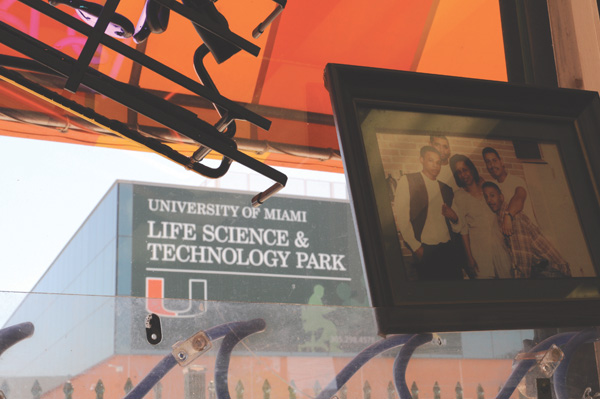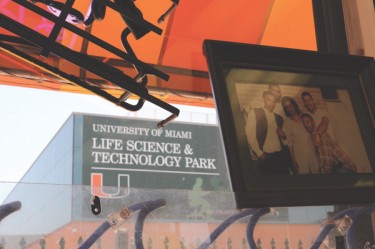

Although the University of Miami has faced protests about the Life Science and Technology Park set to open in Overtown, a historic black district of Miami, some local businesses and residents who live or work by the project believe it will be beneficial to the area.
There are currently two restaurants, two convenience stores and a fast food chicken drive-through within walking distance from the new building, which serve as hangout spots for locals. These residents are aware new people will come to the area once the park opens, but some are still surprised to see college students walk the streets.
An Overtown resident who goes by Cano sat at a bar stool among friends in the San Juan Latin Café. The bartender, a woman who spoke no English, served him coffee.
“That is a good-looking building,” he said, gesturing with open arms to indicate its large size.
The Life Science and Technology Park is a recently constructed research facility that will open in June. It is situated on seven acres in the Health District between I-95 and Miami Dade College Medical Center.
Overtown is a low-income residential community. Its housing struggles with overcrowding and dilapidation. Much of the area that surrounds the large medical buildings of the district is industrial or remains empty lots. Local restaurant, convenience store and auto repair businesses are also neighbors of the new structure.
Trey Mashni opened his business, Yoanna’s Grocery Store, a few months ago around the same time the project began. The store he previously owned in Little Haiti had its appearance destroyed for six months by an industrial project.
“Any type of building is good and better than nothing, especially on an open lot like that,” Mashni said. “They did a good job getting it built quick and without disrupting anybody.”
However, others in the neighborhood are concerned that the new building will negatively impact and potentially destroy Overtown.
Bishop James Adams, chairman of the Overtown Community Oversight Board, has argued that the park was founded on unjust principles and that it will cause displacement for residents of the community. He along with many others believes it is the responsibility of the university and Wexford Science and Technology, the developers, to commit to a long-term agreement to help Overtown redevelop because the project utilizes property and tax dollars from the community.
“You are using public funds to profit privately. You steal from the poor to give to the rich. Classic Robin Hood in reverse,” Adams said.
He feels the promises it makes to help are not legitimate. The Overtown Alliance, which is made up of residents who make recommendations, asked for a legally binding agreement on commitments to help the community. Along with an activist group at the university, Students Towards a New Democracy (S.T.A.N.D.) has written a plan titled the Sustainable Community Benefits Agreement. The university has yet to sign. President Shalala sent an e-mail to students and faculty to defend the institution’s integrity in response to protests. Bishop Adams is appalled that decision makers from the university have yet to “come to the table.”
“I heard recently that we are asking too much, that they can’t deliver housing, but are willing to provide little trinkets,” Adams said. “Was the university asking too much for millions of dollars off the tax backs of the poor? We are asking so much because we are giving so much.”
According to the Community Benefits Agreement, there are financial incentives for buildings in poor areas, which are known as enterprise zones. Developers can receive tax refunds and credit in these zones but not in more financially secure communities.
Adams feels the university has taken advantage of the people in the community with its capitalistic motives.
“They say they don’t sign agreements, but that is a lie because they have signed one with the community of Coral Gables,” he said. “I am the last to play the race card, but it makes me wonder if they only make agreements with communities that are not predominately African American.”
Nonetheless, some residents believe the Life Science and Technology Park can transform the area.
“This is why we are here, we struggle now, but we hope once the park opens we will do very well,” said Jose Abreu, the restaurant’s owner. “The man in charge eats here regularly. People don’t know how advanced and sophisticated this facility really is.”
While an influx of international intelligence could stimulate innovation in biotechnology at the park, the new demographic may alter the average income of those who live in the area. Property taxes and rent rates risk an unaffordable rise for the many current residents who struggle financially. Some members of the community fear they will be forced out if they fail to fill a productive niche in the new industrious environment.
Cano, who has lived in the community for over a decade, feels differently.
“This is my neighborhood, even if the University of Miami has joined it,” he said.
Chelsea Kimmey may be contacted at ckimmey@themiamihurricane.com.





